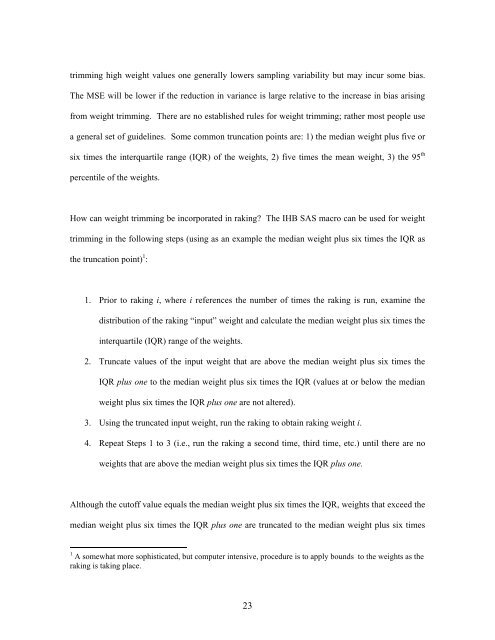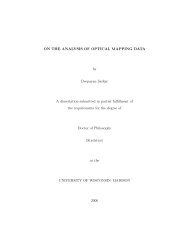Practical Considerations in Raking Survey Data
Practical Considerations in Raking Survey Data
Practical Considerations in Raking Survey Data
Create successful ePaper yourself
Turn your PDF publications into a flip-book with our unique Google optimized e-Paper software.
trimm<strong>in</strong>g high weight values one generally lowers sampl<strong>in</strong>g variability but may <strong>in</strong>cur some bias.<br />
The MSE will be lower if the reduction <strong>in</strong> variance is large relative to the <strong>in</strong>crease <strong>in</strong> bias aris<strong>in</strong>g<br />
from weight trimm<strong>in</strong>g. There are no established rules for weight trimm<strong>in</strong>g; rather most people use<br />
a general set of guidel<strong>in</strong>es. Some common truncation po<strong>in</strong>ts are: 1) the median weight plus five or<br />
six times the <strong>in</strong>terquartile range (IQR) of the weights, 2) five times the mean weight, 3) the 95 th<br />
percentile of the weights.<br />
How can weight trimm<strong>in</strong>g be <strong>in</strong>corporated <strong>in</strong> rak<strong>in</strong>g? The IHB SAS macro can be used for weight<br />
trimm<strong>in</strong>g <strong>in</strong> the follow<strong>in</strong>g steps (us<strong>in</strong>g as an example the median weight plus six times the IQR as<br />
the truncation po<strong>in</strong>t) 1 :<br />
1. Prior to rak<strong>in</strong>g i, where i references the number of times the rak<strong>in</strong>g is run, exam<strong>in</strong>e the<br />
distribution of the rak<strong>in</strong>g “<strong>in</strong>put” weight and calculate the median weight plus six times the<br />
<strong>in</strong>terquartile (IQR) range of the weights.<br />
2. Truncate values of the <strong>in</strong>put weight that are above the median weight plus six times the<br />
IQR plus one to the median weight plus six times the IQR (values at or below the median<br />
weight plus six times the IQR plus one are not altered).<br />
3. Us<strong>in</strong>g the truncated <strong>in</strong>put weight, run the rak<strong>in</strong>g to obta<strong>in</strong> rak<strong>in</strong>g weight i.<br />
4. Repeat Steps 1 to 3 (i.e., run the rak<strong>in</strong>g a second time, third time, etc.) until there are no<br />
weights that are above the median weight plus six times the IQR plus one.<br />
Although the cutoff value equals the median weight plus six times the IQR, weights that exceed the<br />
median weight plus six times the IQR plus one are truncated to the median weight plus six times<br />
1 A somewhat more sophisticated, but computer <strong>in</strong>tensive, procedure is to apply bounds to the weights as the<br />
rak<strong>in</strong>g is tak<strong>in</strong>g place.<br />
23
















